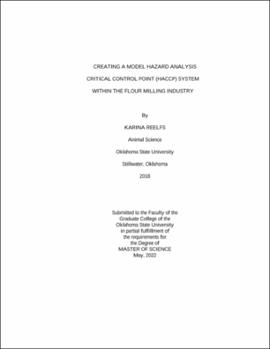| dc.contributor.advisor | Jadeja, Ravi | |
| dc.contributor.author | Reelfs, Karina | |
| dc.date.accessioned | 2023-04-03T20:51:35Z | |
| dc.date.available | 2023-04-03T20:51:35Z | |
| dc.date.issued | 2022-05 | |
| dc.identifier.uri | https://hdl.handle.net/11244/337226 | |
| dc.description.abstract | Foodborne illnesses and diseases have been a major concern to the food industry worldwide. Foodborne illnesses are caused by several disease-causing germs that have contaminated food. Researchers have identified over 250 foodborne diseases. Most of them are infectious, caused by various bacteria; and parasites. Chemicals and harmful toxins are other factors that can contaminate food and cause foodborne illnesses. The top viruses that cause foodborne illnesses in the US are norovirus, salmonella, clostridium perfringens, campylobacter, and staphylococcus aureus (staph). Some germs do not cause as many illnesses. However, when they do, they have a higher risk of causing individuals to end up hospitalized. Those viruses include Clostridium botulinum (botulism), listeria, Escherichia coli (E. coli), and vibrio (Hedberg, 1999). According to the Centers for Disease Control and Prevention (CDC), they estimate that 48 million people get sick from a foodborne illness, 128,000 get hospitalized, and 3,000 die each year (FDA 2022). The purpose of this study is to show how the Hazard Analysis Critical Control Point (HACCP) system has been proven to be effective in the food industry. It is a food safety tool that manages the hazards associated with food production plants and farm-to-table within the past three decades, the U.S. government agencies have issued a succession of regulations that require a HACCP plan development for certain types of foods. The HACCP plan system is a proactive control approach and is globally accepted for manufacturers to prevent recalls and outbreaks, along with reducing financial losses (Gillion 2005). | |
| dc.format | application/pdf | |
| dc.language | en_US | |
| dc.rights | Copyright is held by the author who has granted the Oklahoma State University Library the non-exclusive right to share this material in its institutional repository. Contact Digital Library Services at lib-dls@okstate.edu or 405-744-9161 for the permission policy on the use, reproduction or distribution of this material. | |
| dc.title | Creating a model Hazard Analysis Critical Control Point (HACCP) system within the flour milling industry | |
| dc.contributor.committeeMember | DeSilva, Udaya | |
| dc.contributor.committeeMember | Ramsey, Jon | |
| dc.contributor.committeeMember | Cartmell, Dwayne | |
| osu.filename | Reelfs_okstate_0664M_17706.pdf | |
| osu.accesstype | Open Access | |
| dc.type.genre | Thesis | |
| dc.type.material | Text | |
| thesis.degree.discipline | International Agriculture | |
| thesis.degree.grantor | Oklahoma State University | |
